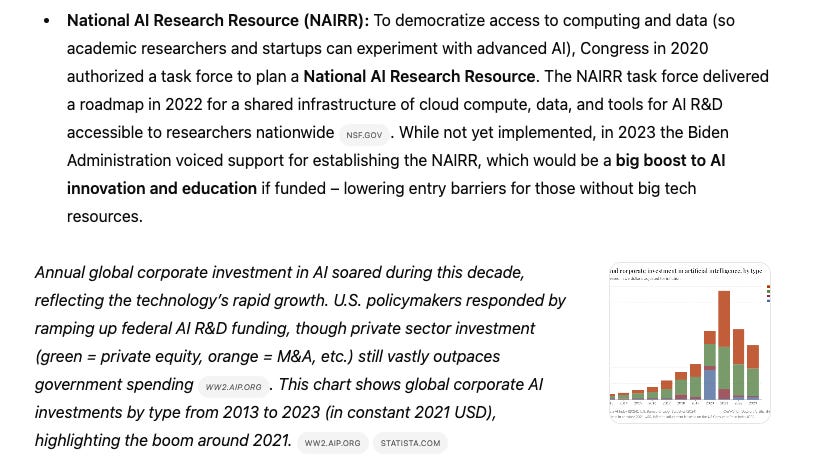How AI Can Speed Novo Nordisk Up to $15 Million Daily Revenue
Also: A look at China’s new hyped AI agent, how a bestselling author-economist uses chatbots, and more.
AI can lead to meaningful time and cost reductions, and an example from Ozempic/Wegovy maker Novo Nordisk shows how, with an interesting twist in how a change in large language model made a critical difference. That story and a few others in this week’s newsletter.
Number of the Week
$30 billion. Despite having no product or revenue, this is the hefty valuation of the AI company Safe Superintelligence Inc. (SSI) after their latest funding round of $2 billion. Go big or go home. [Wall Street Journal]
How AI can help Novo Nordisk get to $15 million daily revenue earlier

In mid-2023, Danish pharmaceutical maker of Ozempic fame, Novo Nordisk, started an AI initiative that is now beginning to show significant results.
An internally-developed tool, NovoScribe, can write reports that describe the methodology, execution, results, and analyses of the clinical trials that are part of the process of getting a new product approved by the authorities. The reports can be hundreds of pages long and were previously done by a team of 50 human writers — now it’s three, and the production time has been reduced from 15 weeks to 10 minutes, The Information writes.
Previously, NovoScribe used models from OpenAI and Meta, but they achieved far better results with Claude from Anthropic, which has a better understanding of the terminology of medicine and the clinical context, Louise Skov Lund, Head of Content Digitalisation at Novo Nordisk, tells Prompt, a Danish radio program on AI.
Claude creates a first draft, which is then evaluated by experts. Novo Nordisk also finds that the AI model excels in writing in an objective, neutral tone that fits well with what authorities want in this context.
“Claude is better at following rules and direction than humans necessarily are,” Louise Skov Lund says.
The 47 redundant human writers have been assigned to other tasks instead, no one has been fired, but the efficiency boost means that the fast-growing Ozempic maker will reduce its hiring in the area going forward.
For Novo Nordisk, getting a product to market as early as possible has tangible benefits.
“Each day of delay means patients don’t get the treatments they need and the company cannot start to recover its R&D costs,” Louise Skov Lund says in a case study of the project.
Today, NovoScribe assists in around 30% of all the clinical study trial reports at the company, with an expectation that the number will rise to 90% later this year.
“Each day sooner a medicine gets to market can add around $15 million in revenue to the company,” Waheed Jowiya, Digitalisation Strategy Lead at Novo Nordisk, says.
A look at China’s new hyped AI agent
It’s been dubbed the second “DeepSeek” moment for China, the release of the agentic system Manus AI last week, and now that the initial hype of demos has faded, let’s take stock.
Manus works by breaking down tasks into a number of sub-tasks, and then executing those one at a time, which can be quite a lengthy process — a user reports that Manus took more than two hours to generate a course for him. For comparison, OpenAI’s Deep Research tool works in the 5 to 30 minutes range.
But the output from Manus AI, which it has later been revealed uses Claude and the Chinese language model series Qwen, is more comprehensive and detailed, it can give you a full-working, deployed website, handle audio files, interact with websites, like using the filter function to find something based on certain criteria.
I tried giving Deep Research the exact same prompt as in one of the examples on Manus’s website, and even though it explicitly asked for an illustrated report on the topic, it outputted only one graph, whereas Manus provided multiple and more detailed ones.

How a bestselling author-economist uses AI
Tyler Cowen has been writing about AI’s impact on work for more than a decade, and the New York Times-bestselling author has also implemented the technology in his own work, he tells listeners of the How I Write podcast.
For instance, when he is preparing for an episode of his popular podcast Conversations with Tyler, he uses the technology heavily as a “secondary literature”: where before he might have bought 20-30 books to prepare for a guest, now it’s only two or three, and then he interrogates LLMs about the subjects in those books.
Worried about hallucinations? Not so much. He’s not the one who’s supposed to come up with the answers, anyway, just the questions, he reasons.
And if you want to use anything you learn, you’ve got to double-check it anyway, regardless of the source:
“It could be a human, it could be Einstein, it could be the Encyclopedia Britannica. So the fact that you should double-check what you learn from an AI is not an extra burden.”
Tyler Cowen’s best prompting tip for chatbots:
“Put humans out of your mind. Imagine yourself either speaking to an alien or maybe a non-human animal. Just feel a need to be more literal.”
Image of the Week
Text-based image generation and editing from Google is quite interesting. Available now in Google AI Studio (Model: Gemini 2.0 Flash Experimental).
Exciting news out there?
The renowned British author Jeanette Winterson praises the creative writing skills of a recent example from OpenAI that their CEO Sam Altman shared on X.
“AI is trained on our data. Humans are trained on data too – your family, friends, education, environment, what you read, or watch. It’s all data. AI reads us. Now it’s time for us to read AI.” [The Guardian]
Feedback?
Thanks for reading, and feel free to respond directly with suggestions for improvement, tips, and anything in between :)



